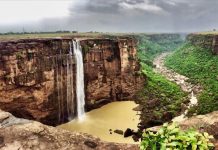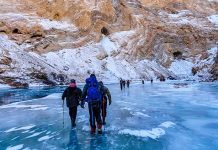20 Most Mysterious Places In The World All Travelers Should Visit
Our beautiful planet never ceases to amaze us by offering places with sights that are so spectacular, it is just simply indescribable. In every corner of our world, there are areas, whether naturally occurring or man-made, that are beyond our wildest imagination. Some spots are so mysterious and bizarre that it almost makes us wish we had paid better attention in our high school science class to figure out just how it came to be. You know there has to be an explanation for how it occurred, but for the life of you, you can’t figure it out. Scientists are constantly searching for the answers to the universe, so why not start with our very own planet?
Today we will take a look at 20 mysterious places on our planet and reveal the secrets to the mystery that surrounds them. Lots of them are somewhat challenging to get to, if at all possible or off limits to the public. Other spots are or were at one time, busy tourist destinations only because of their mysterious nature. You will be amazed to learn the secrets of the places on this list as they are as beautiful as they are baffling. If you are a travel geek, these are just some of the places you will need to scratch off your bucket list.
20 SALTY YET SWEET! SALAR DE UYUNI – BOLIVIA
 In the Andes mountains in southwest Bolivia sits the world’s largest salt flat – Salar de Uyuni. It’s believed that it came to be when a prehistoric lake dried up and left a nearly 11,000 sq. km desertlike mass. Composed of brilliant white salt rock formations sprinkled with cacti-studded islands, Salar de Uyuni (Uyuni Salt Flats) has a very unique ecosystem. Its salty crust is extraordinarily flat and only slightly varies over the entire area. The crust also covers a pool of lithium-rich brine which makes Salar de Uyuni a breeding ground for pink flamingos. Between half and two-thirds of the world’s known lithium reserves are found there and are being extracted.
In the Andes mountains in southwest Bolivia sits the world’s largest salt flat – Salar de Uyuni. It’s believed that it came to be when a prehistoric lake dried up and left a nearly 11,000 sq. km desertlike mass. Composed of brilliant white salt rock formations sprinkled with cacti-studded islands, Salar de Uyuni (Uyuni Salt Flats) has a very unique ecosystem. Its salty crust is extraordinarily flat and only slightly varies over the entire area. The crust also covers a pool of lithium-rich brine which makes Salar de Uyuni a breeding ground for pink flamingos. Between half and two-thirds of the world’s known lithium reserves are found there and are being extracted.
19 STAR LIGHT, SEA BRIGHT – PUERTO MOSQUITO, PUERTO RICO

There is nothing more intriguing than watching bioluminescent plankton sparkle and dance in the water. Off the east coast of Puerto Rico, the beautiful bright glow of these creatures light up the waters of Puerto Mosquito. It has become an international tourist attraction for this amazing show and holds the world title of being the brightest bioluminescent bay. Dinoflagellates, known as Pyrodinium bahamense, discharge a blue glowing chemical concoction when they are agitated by the waves or people’s bodies as they swim. In 2017 Hurricane Maria took a toll on the precious plankton, but they have been slowly recovering since then.
18 CHILL OUT – MENDENHALL ICE CAVES – JUNEAU, ALASKA

Just 12 miles outside of Alaska’s capital, Juneau, sits a 12-mile long glacier in Mendenhall Valley called the Mendenhall Ice Caves. This federally protected glacier is as spectacular as it is weird. There are very few places in the world where you can see water in its different stages at once. This 3,000-year-old glacier has been strictly monitored since 1942 and has receded about 2 miles since 1958. With the increased rate of glacial recession, the melting ice and flow of water flow around the sides of the glacier have formed the ice caves and is constantly carving out new ones. The ice caves will eventually collapse and disappear as the melting continues, so see them while you still can.
17 CHINA TAKING “RED” TO THE NEXT LEVEL – RED BEACH – PANJIN, CHINA

Most people will correlate the word beach with sand, but this is not the case with Red Beach in Panjin, China. This so-called “beach” is not comprised of sand, but instead of a red grassy plant called Suaeda Salsa. Being one of only a few species that can live in highly alkaline soil, the Sueda’s growth cycle begins in April with a light red color and in autumn turns to a vivid red. Red Beach is part of the biggest reed marsh and wetland area in the world so it was granted state-level protection in 1988. It is home to many different kinds of bird and wild animals.
16 IT SHOULD BE CALLED LAKE PEPTO-BISMOL – LAKE HILLIER – AUSTRALIA

In Western Australia sits a bright pink body of water called Lake Hillier. Unless you have access to a helicopter, it’s not very accessible, but it is very noticeable. It has a very glossy pink sheen due to the type of algae that reside in it. The color is so condensed that even if you put some of this lake water in a pale, it would still remain bright pink. This 2,000-foot long lake is small, but you can swim in it if you can get there. Well, not really, because it is prohibited by local laws for tourists to even visit it.
15 YES, IT’S A DEVILS BRIDGE! RAKOTZBRÜCKE – GERMANY

Tucked away in a small park in Saxony, German sits a bridge so unique in its construction that people travel from all over the world to see it. Rakotzbrücke was built in 1860 and is one of several “Devil’s Bridges” in Europe. Folktale has it that only Satan could have created something so unsafe to walk across. Walking on the bridge is prohibited and “Do Not Enter” signs are clearly posted on both sides. Entirely man-made, the jagged rocks that jet out on both ends of the bridge and the sharp rock that sit out in the water give the bridge a very sinister appearance.
14 THIS WAS NOT THE BLUE LAGOON BROOK SHIELDS KNEW, ICELAND

Iceland has lots of geothermal hotspots since it is a volcanic island. The Blue Lagoon is probably Iceland’s most famous one and is a huge tourist attraction. Surrounded by volcanic rock and snow, the Blue Lagoon is man-made. Its source of water comes from a nearby geothermal power plant and is renewed every two days. The water temperature averages 99–102 °F and is mineral rich with sulfur and silica. People started bathing in it in 1981 for its supposed healing powers. In 1992 an official bathing facility was opened for the public. It’s believed to help people who suffer from psoriasis and other various skin diseases.
13 THEY LOOK PREHISTORIC -SENTINELS OF THE ARCTIC, FINLAND

Beyond a shadow of a doubt, one of the most spectacular sights to see in the world are the Sentinels of the Arctic in Finland. Lapland is the Finnish region where this picture postcard phenomenon occurs. In the wintertime, the trees get covered with snow and ice in such a way that they take on strange and interesting formations. Although temperatures can drop to -40°C, even the fish and marine mammals remain there during the harsh winter. The tree’s armor of ice is breathtakingly enhanced amongst the soft skies as they just sit and wait for spring to come to break the icy spell.
12 BUBBLE, BUBBLE TOIL & TROUBLE – ABRAHAM LAKE, WESTERN ALBERTA, CANADA

Alberta, Canada’s Lake Abraham is iconic for its ice bubbles, with their lilypad like appearance, that forms just underneath its frozen surface. These winter jewels are stunning but you don’t want to be anywhere close to them if one pops. The bubbles are literally frozen pockets of highly flammable methane gas so you better not be lighting a match near one. Simply put, here’s how it works: dead organic matter from animals and leaves sink to the bottom of the lake. Bacteria eat it then poop out methane. When the methane comes into contact with the frozen water it makes the beautiful white floating blobs.
11 THESE ARE THE REAL CELEBRITIES – SEA OF STARS OF THE VAADHOO ISLAND, THE MALDIVES

The Maldives really have it all when it comes to spectacular scenery. The tiny island of Vaadhoo has only about 500 inhabitants, but it’s known globally for its Sea of Stars phenomenon. Blue waves glow like the star-filled night sky as they lap the sandy shore. The marine microorganism responsible for the lights is called Phytoplankton. Although it looks magical, the blue toxin can be harmful to people, fish, and other creatures. It’s a defense mechanism for the phytoplankton to warn other organisms not to eat them. If you want to see bioluminescence on land, you can check out the fireflies or glow worms which are not worms at all, but instead are fly larvae.
10 THE GREAT DIVIDE – CONFLUENCE OF RHONE AND ARVE RIVERS, GENEVA, SWITZERLAND

There is a place in Geneva, Switzerland where two rivers meet, but that’s not anything extraordinary. The fact that you can clearly see a color difference between the two rivers is what is so special about it. There is such a defined color contrast between the Rhone and Arve rivers that it is a beautiful sight to see when they meet. The Rhone river, on the left in the picture, exits Lake Lehman. The Avre river, on the right in the picture, gets much of its water from Chamonix valley glaciers, mainly the Mer de Glace. This water has high amounts of salt in it which makes the color muddier and lighter creating the striking contrast.
9 THE FLINSTONE-LIKE BUBBLE HOUSE, TOURETTES-SUR-LOUP, FRANCE

This oddly-styled house was designed by Antti Lovag who is considered to be an organic architect. This unique property was designed with maximum viewing in mind of the Mediterranean sea. The almost 40-year-old bulbous structure has been declared by the French Ministry of Culture as a designated historic monument. The home boasts panoramic views of the sea by day, with celestial views that are out of this world at night. A waterfall, stream, and garden with palms and exotic vegetation sit smack in the center of the home. Built into the home are furniture, cupboards, and shelving that are unique and space-saving.
8 NO GUESSING WHY IT’S NAMED BLOOD FALLS, ANTARCTICA

In 1911, Griffith Taylor an Australian geologist was the first to explore the area that is now named after him in Victoria Land in East Antarctica. Amidst the brilliant white snow, Blood falls spill its blood red outflow of iron oxide-rich hypersaline water onto the icy surface of West Lake Bonney in Taylor Valley. It was first believed that the blood color of the falls came from red algae, but it was later determined not to be the case. From a subglacial pool, covered in about 1,300 ft. of ice, sporadically the salty water emerges from tiny fissures in the ice cascades.
7 A CRYSTAL LOVERS PARADISE, THE GIANT CRYSTAL CAVE AT NAICA MINE, MEXICO

Cueva de Los Cristales in Spanish, or Cave of the Crystals can be found in Naica, Chihuahua, Mexico. This giant crystal cave is connected to the Naica Mine. It’s at an astounding depth of 300 meters (980 ft.) and is extremely humid (90-99% humidity) and hot with temperatures reaching as high as 58 °C (136 °F). Even with the proper protection, people can only stand to be in the cave for about 10 minutes. For these reasons, the cave is relatively unexplored. This cave houses some of the largest natural selenite crystals ever found. The largest crystal to date has weighed 55 tons and has a diameter of 13 ft. and is 39 ft. in length.
6 SOMEWHERE OVER THE RAINBOW IS VINICUNCA RAINBOW MOUNTAIN, PERU

Covered in beautifully distinctive wide lines of rainbow colors, Vinicunca Rainbow Mountain in Peru is a stunning sight to see for sure. With intense reds, pinks, greens, yellows and pastel blues Montaña de Siete Colores (local translation is “seven-colored mountain”) is quite appropriately named. Reaching an altitude of 5,200 meters (17,100 feet) above sea level, Rainbow Mountain in the Cusco Region of the Andes, the effects of its altitude can be crippling. The terrain is also very steep and can be quite treacherous. It’s best to have a local guide take you on the hike because they know the terrain. Don’t forget the oxygen and ibuprofen!
5 A GIRL’S BEST FRIEND – MIR MINE, SIBERIA

The world’s largest open pit diamond mine is 1,722 foot deep and 3,900 feet wide. Inactive since 2001, the Mir Mine sits in Eastern Siberia, Russia. It holds the number 2 spot in the world for being the largest excavated hole, Bingham Canyon Mine is #1. Soviet geologists discovered the diamond-bearing deposits there in 1955. In the 1960’s, 20% of the 10,000,000 carats mined annually were of gem quality, which is a very good yield. The largest diamond found in the mine was in 1980 and it weighed 69 grams for an eye-popping 342.5-carat show stopper. The company that ran the mine from the 90’s on reported a $600 million dollar profit annually from diamond sales.
4 LEAVE IT TO THE PARISIANS TO SPACE SAVE – THE CATACOMBS, PARIS

Who would ever guess that beneath the streets of “The City of Light” lies a burial place with 6 million bodies? In Paris, France there is an extensive underground tunnel network called The Catacombs. In an effort to reduce the city’s overflowing cemeteries, work started on it in the late 18th century. Every night, covered wagons took the remains from cemeteries around Paris and brought them to a mine shaft near the Rue de la Tombe-Issoire. In the early 19th century, it became a novelty-place for private events and concerts. In 1874 it was opened to the public for visitation. Today it is a museum managed by Paris Musées.
3 LIZ TAYLOR WOULDN’T RECOGNIZE THE PLACE, VAROSHA, CYPRUS

When Turkey invaded Cyprus in 1974, the inhabitants of Varosha, a resort city on the coast of Cyprus quickly fled. This abandoned city stands frozen in time showing life as it was in 1974. From afar, it looks like any other resort town, but if you take a closer look you can see the town is completely deserted. Before it came under Turkish control, it was described as the “French Riviera of Cyprus.” Celebrities like Brigitte Bardot, Richard Burton, and Elizabeth Taylor have all stayed at the Argo Hotel there. Today, entry to this ghost town in forbidden to the public.
2 THIS PLACE PUTS RENO TO SHAME, FLY GEYSER, NEVADA

In 1964 Fly Geyser was accidentally created while exploring for sources of geothermal energy. During the well’s drilling, it was either left unplugged or was capped off incorrectly which caused minerals to accumulate and create a travertine mound which continues to grow at the Geyser’s base. Located on private land in Nevada, the Geyser shoots water constantly up into the air about 5 feet. Algae learned to survive in the extreme environment and have given the Geyser beautiful red and green colors. Since the geyser is located on private land, it’s not open for the public to view but some small tours have been made available for those lucky few.
1 CALL THE DOCTOR! SPOTTED LAKE KHILUK, BRITISH COLUMBIA, CANADA

Spotted lake Khiluk is considered to be the most mineralized lake in the world. Located in British Columbia’s Okanagan Valley, this lake looks just like any other one except when the water evaporates in the summer. That’s when hundreds of huge brine-filled pools appear, giving the lake a colorful spotted green, yellow and blue polka-dotted landscape. High mineral concentrations of calcium, magnesium sulfate and sodium sulfates collect in the pools and the varying colors come from the different concentrations. Minerals from the lake were used to make ammunition during World War I. British Columbia Visitor Centre says, “stories are that prior to this mineral mining the lake displayed an even greater variety of colors and an even greater artistic beauty.”
References: viralnova.com, traveltriangle.com, atlasobscura.com, boredpanda.com, smithsonianmag.com



















